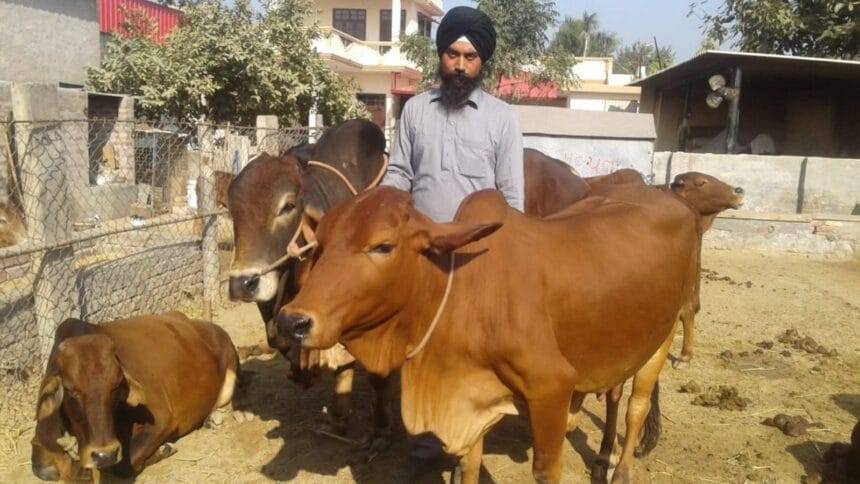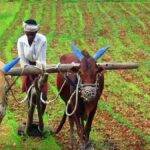Main Points In Hindi (मुख्य बातें – हिंदी में)
-
साहीवाल गायों की प्रासंगिकता: फरीदकोट के सत्कार सिंह रोमाना ने साहीवाल गायों को उच्च दूध उत्पादन वाली होल्स्टीन फ़्रीज़ियन (एचएफ) गायों की तुलना में एक लाभदायक और टिकाऊ विकल्प साबित किया है, भले ही साहीवाल गायों का दूध उत्पादन कम हो।
-
जैविक खेती का महत्व: रोमाना ने अपनी 22 एकड़ भूमि में से 4 एकड़ में जैविक खेती अपनाई है, जिससे उन्हें गुणवत्ता वाले उत्पाद प्राप्त होते हैं और बाजार में उनकी मांग बढ़ी है। वे जैविक दालें और गुड़ की बिक्री से अच्छी आय प्राप्त कर रहे हैं।
-
खुद की मार्केटिंग: रोमाना दूध और घी की मार्केटिंग स्वयं करते हैं, और उनका कहना है कि उनकी उत्पादों की गुणवत्ता के कारण मांग इतनी बड़ी है कि वे कभी-कभी पूरी नहीं कर पाते।
-
कम रखरखाव लागत: साहीवाल गायें पंजाब की जलवायु में बेहतर ढंग से पनपती हैं और उनकी रखरखाव लागत एचएफ गायों की तुलना में काफी कम होती है, जिससे किसान ज्यादा लाभ कमा सकते हैं।
- दीर्घकालिक लाभ: रोमाना के अनुसार, साहीवाल गायों का जीवनकाल लंबा होता है और उनके उत्पादक जीवन में 10 बछड़ों का जन्म संभव है, जबकि एचएफ गायें केवल 4-6 बछड़ों तक सीमित रहती हैं।
Main Points In English(मुख्य बातें – अंग्रेज़ी में)
Here are the main points from the article about Satkar Singh Romana and his sustainable farming practices in Punjab:
-
Sustainable Dairy Farming: Satkar Singh Romana has found success in dairy farming with Sahiwal cows, which produce less milk than Holstein Friesian (HF) cows, but their milk is higher in fat content and value. He sells Sahiwal milk at nearly double the price of HF milk, emphasizing quality over quantity.
-
Organic Farming Practices: He cultivates four acres of his 22-acre farm using organic methods, producing various crops. Romana’s organic sugarcane yields significant annual profit, and he uses the waste from his cows to enrich the soil, reducing reliance on chemical fertilizers.
-
Economic Benefits: By focusing on Sahiwal cows and organic farming, Romana has eliminated debt and increased profitability. He estimates earning 60% more compared to conventional methods of farming just wheat and rice, managing to grow most of his family’s food on his land.
-
Adaptation to Climate: Sahiwal cows thrive in Punjab’s diverse climate, requiring less expensive maintenance compared to HF cows, which face heat stress and require costly cooling systems. Their longer productive lifespan and ability to give birth to more calves further enhance their profitability.
- Cultural Preservation and Success: Romana’s endeavors are not just about economic gain; he aims to preserve agricultural traditions through Sahiwal cattle farming. He believes that hard work and dedication are key to thriving in agriculture without incurring debt.


Complete News In Hindi(पूरी खबर – हिंदी में)
पंजाब के मध्य में, जहां होल्स्टीन फ़्रीज़ियन (एचएफ) गायें अपने उच्च दूध उत्पादन के साथ डेयरी परिदृश्य पर हावी हैं, फरीदकोट के रोमाना अलबेल सिंह गांव के किसान सत्कार सिंह रोमाना (48) यह साबित कर रहे हैं कि परंपरा अभी भी पनप सकती है। जबकि राज्य में 2.5 मिलियन से अधिक गायें हैं, जिनमें लगभग 1.4 से 1.5 मिलियन एचएफ गायें और केवल 40,000 स्वदेशी साहीवाल गायें शामिल हैं, रोमाना ने दूध की कम पैदावार के बावजूद साहीवाल गाय को अधिक लाभदायक और टिकाऊ विकल्प पाया। अपने 22 एकड़ के खेत में से केवल 4 में जैविक खेती के साथ, मात्रा से अधिक गुणवत्ता पर ध्यान देने से उन्हें न केवल जीवित रहने बल्कि फलने-फूलने में भी मदद मिली है।
उनकी यात्रा 2015 में शुरू हुई, जब रोमाना ने डेयरी फार्मिंग में प्रवेश किया और तीन साहीवाल बछड़े खरीदे। आज, उनके पास 18 गायें हैं, जिनमें से 10 दूध दे रही हैं। वह बताते हैं कि हालांकि साहीवाल गायें एचएफ गायों की तुलना में कम दूध देती हैं – 20-25 लीटर की तुलना में प्रतिदिन लगभग 8-9 लीटर, इसके दूध में वसा (4-5%) अधिक होती है, जो इसे कहीं अधिक मूल्यवान बनाती है। वह साहीवाल गाय का दूध एचएफ गाय के दूध से लगभग दोगुनी कीमत पर बेचते हैं, और उनके ‘देसी घी’ की कीमत इसकी शुद्धता और मांग के कारण 2,500 रुपये प्रति किलोग्राम है, जबकि अधिकांश देसी घी बाजार में 400 रुपये के बीच उपलब्ध हैं। और 1500 रुपये प्रति किलो.
रोमाना, जिनके पास अपने भाई और वीरपाल कौर के साथ संयुक्त रूप से 22 एकड़ जमीन है, दूध और देसी घी की मार्केटिंग खुद संभालते हैं। “मांग इतनी बड़ी है कि हम इसे पूरा नहीं कर सकते,” वह कहते हैं, उनका ग्राहक आधार उत्पादों की गुणवत्ता और शुद्धता को महत्व देता है।
वह बताते हैं कि साहीवाल गायें एचएफ गायों की तुलना में अधिक किफायती हैं, खासकर पंजाब की जलवायु में, जो चिलचिलाती गर्मियों से लेकर ठंडी सर्दियों तक होती है। जबकि एचएफ गायें गर्मी के तनाव से पीड़ित होती हैं और उन्हें महंगी शीतलन प्रणाली की आवश्यकता होती है, साहीवाल गर्मी और ठंड दोनों में पनपती हैं। साहीवाल गायों के रखरखाव की लागत काफी कम है, क्योंकि उन्हें कम गुणवत्ता वाले चारे और पशु चिकित्सा देखभाल की आवश्यकता होती है। कम दूध उत्पादन के बावजूद, साहीवाल गायों का उत्पादक जीवन लंबा होता है।
“एक साहीवाल गाय अपने जीवनकाल में 10 बछड़ों को जन्म दे सकती है, जबकि एक एचएफ गाय आमतौर पर 4-6 से अधिक नहीं दे सकती है,” वह कहते हैं, वह हर महीने बाजार में लगभग 750-800 लीटर गाय का दूध बेचते हैं। 80 रुपये प्रति किलो और हर महीने 5-7 किलो घी जो लगभग 72,000 से 80,000 रुपये तक आता है। वह चारे पर 20,000 से 25,000 रुपये खर्च करते हैं.
अपनी 22 एकड़ जमीन में से चार पर, वह जैविक खेती करते हैं, दालें (गर्मी और सर्दी दोनों मौसम), गन्ना और तिलहन की खेती करते हैं। शेष 18 एकड़ भूमि पारंपरिक धान और गेहूं के लिए समर्पित है। वह केवल एक एकड़ गन्ने की खेती से लगभग 4 लाख रुपये प्रति वर्ष का जैविक गुड़ और गुड़ पाउडर बेचते हैं। रोमाना का कहना है कि जैविक उत्पाद की भारी मांग है और जो लोग उनका गुड़ खरीदते हैं, वे कभी कहीं और नहीं जाते हैं। पंजाब कृषि विश्वविद्यालय (पीएयू) और फरीदकोट के जिला कृषि विभाग के मार्गदर्शन में, उनका जैविक खेती कार्य फल-फूल रहा है। उनके साहीवाल झुंड का गोबर और मूत्र उनकी जैविक खेती प्रथाओं का अभिन्न अंग हैं, जो रासायनिक उर्वरकों की आवश्यकता के बिना मिट्टी को समृद्ध करते हैं।
यह स्थायी चक्र यह सुनिश्चित करता है कि उसका परिवार जो भोजन खाता है उसका 80% उनकी भूमि पर उगाया जाता है। बाजार से केवल नमक, चाय और कुछ दालें जैसी चीजें ही खरीदी जाती हैं। “हम अपनी जैविक दालें बाजार से लगभग 1.5 गुना अधिक कीमत पर बेचते हैं क्योंकि हम प्रत्येक रबी और खरीफ सीजन में औसतन 17-18 क्विंटल दालें और तिलहन का उत्पादन करते हैं और आसानी से 130 रुपये से 150 रुपये प्रति की दर पर बेच सकते हैं। किलो,” वीरपाल ने कहा। किसान की सबसे गौरवपूर्ण उपलब्धियों में से एक है कर्ज मुक्त होना। “खेती के लिए कड़ी मेहनत और व्यक्तिगत रुचि की आवश्यकता होती है। लेकिन अगर आप समर्पित हैं तो यह फायदेमंद है,” रोमाना कहती हैं। जैविक फसलें उगाकर और साहीवाल गायों के झुंड का प्रबंधन करके, उन्होंने ऋण पर भरोसा किए बिना एक लाभदायक उद्यम बनाया है।
उनका कहना है कि उनकी सफलता अथक परिश्रम और जमीन से जुड़े रहने का नतीजा है। “हम न केवल बाजार में बेच रहे हैं, बल्कि अपनी घरेलू जरूरतों का 80% भी पूरा कर रहे हैं, जिसे ज्यादातर किसान अपने खेत होने के बावजूद बाजार से खरीदते हैं, और अपने भविष्य में अपने खेतों से निवेश कर रहे हैं, लेकिन यह संभव है क्योंकि हम हैं हर दिन खेतों में कड़ी मेहनत करते हैं।” वह आगे कहते हैं, “अगर हम अपनी पूरी 22 एकड़ जमीन पर गेहूं और धान उगाते, तो हम फसल को बेचने में सक्षम होते एमएसपी लगभग 24 से 25 लाख रुपये सालाना। इनपुट लागत को पूरा करने के बाद, हम लगभग 17 से 18 लाख रुपये कमाएंगे। लेकिन हमारे डेयरी व्यवसाय और जैविक खेती के तहत चार एकड़ जमीन के साथ, हम लगभग 60% अधिक कमा रहे हैं।
“साहिवाल गायों को पालने का निर्णय केवल जीविकोपार्जन के बारे में नहीं है। यह उस परंपरा को संरक्षित करने के बारे में था जो मेरे द्वारा बेचे जाने वाले दूध और घी जितनी ही मूल्यवान है,” वह कहते हैं।
Complete News In English(पूरी खबर – अंग्रेज़ी में)
In the heart of Punjab, where Holstein Friesian (HF) cows dominate the dairy landscape due to their high milk production, farmer Satkar Singh Romana (48) from the village of Romana Albail Singh in Faridkot is proving that tradition can still thrive. Despite the state having over 2.5 million cows, including about 1.4 to 1.5 million HF cows and only 40,000 indigenous Sahiwal cows, Romana has found the Sahiwal cow to be a more profitable and sustainable option, even with its lower milk yield.
Romana started his dairy farming journey in 2015 by purchasing three Sahiwal calves. Now, he has 18 cows, with 10 currently milking. He explains that even though Sahiwal cows produce less milk compared to HF cows—about 8-9 liters a day compared to 20-25 liters—the fat content in Sahiwal milk (4-5%) is higher, making it more valuable. He sells Sahiwal milk for nearly double the price of HF milk, and his ‘desi ghee’ sells for ₹2,500 per kilogram due to its purity and high demand, while most market ghee prices range from ₹400 to ₹1,500 per kilogram.
Romana, who co-owns 22 acres of land with his brother and Veerpal Kaur, handles the marketing of his milk and ghee himself. “The demand is so high that we can’t keep up,” he says, noting that their customers value the quality and purity of their products.


He further explains that Sahiwal cows are more cost-effective, especially in Punjab’s variable climate, where summers can be extremely hot and winters very cold. While HF cows suffer from heat stress and require expensive cooling systems, Sahiwal cows thrive in both hot and cold conditions. The maintenance cost for Sahiwal cows is low since they require less quality feed and veterinary care. Despite lower milk production, Sahiwal cows also have a longer productive lifespan.
“A Sahiwal cow can give birth to about 10 calves in her lifetime, while an HF cow typically has no more than 4-6,” he adds. Each month, he sells approximately 750-800 liters of milk at ₹80 per kilogram and 5-7 kilograms of ghee, totaling around ₹72,000 to ₹80,000. He spends around ₹20,000 to ₹25,000 on feed.
On four of his 22 acres, he practices organic farming, growing pulses, sugarcane, and oilseeds, while the remaining 18 acres are dedicated to traditional rice and wheat cultivation. From just one acre of sugarcane, he earns about ₹400,000 annually from organic jaggery and jaggery powder. Romana claims there is a strong demand for his organic products, and customers who buy his jaggery never go elsewhere. With guidance from Punjab Agricultural University (PAU) and the district agriculture department in Faridkot, his organic farming practices are flourishing. The manure and urine from his Sahiwal herd play a crucial role in enriching his soil without the need for chemical fertilizers.
This sustainable cycle ensures that 80% of the food his family eats is grown on their land, purchasing only items like salt, tea, and some pulses from the market. “We sell our organic pulses for about 1.5 times the market price, producing an average of 17-18 quintals of pulses and oilseeds each season, easily selling at rates between ₹130 to ₹150 per kilogram,” says Veerpal.
One of Romana’s proudest achievements is being debt-free. “Farming requires hard work and personal interest. But if you are dedicated, it is rewarding,” Romana states. By growing organic crops and managing his herd of Sahiwal cows, he has built a profitable business without relying on loans.
He attributes his success to relentless hard work and staying connected to the land. “We not only sell in the market but also meet 80% of our domestic needs, which most farmers, despite having farmland, still purchase from the market and invest in their futures. But we can do this because we work hard in the fields every day.” He continues, “If we had grown only wheat and rice on our entire 22 acres, we could have made about ₹24-25 lakhs annually from selling crops. After covering input costs, we would earn around ₹17-18 lakhs. With our dairy business and the four acres of organic farming, we are earning about 60% more.”
“Raising Sahiwal cows is not just about earning a living; it’s about preserving a tradition that is as valuable as the milk and ghee I sell,” he concludes.
Source link








